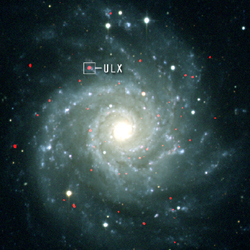March 22, 2005
CXC RELEASE: 05-04
Peculiar outbursts of X-rays coming from a black hole have provided evidence that it has a mass of about 10,000 Suns, which would place it in a possible new class of black holes. The timing and regularity of these outbursts, observed with NASA's Chandra X-ray Observatory, make the object one of the best candidates yet for a so-called intermediate-mass black hole.
Scientists have strong evidence for the existence of stellar black holes that are about 10 times as massive as the Sun. They have also discovered that supermassive black holes with masses as large as billions of Suns exist in the centers of most galaxies. Recent evidence has suggested that a new class of black holes may exist between these extremes - intermediate-mass black holes with masses equal to thousands of Suns.
"It is important to verify the existence of intermediate-mass black holes, because they would bridge the gap between stellar-mass black holes and supermassive black holes in the centers of galaxies," said Jifeng Liu of the University of Michigan in Ann Arbor, and lead author on a paper describing their discoveries that appeared in the March 1 issue of the Astrophysical Journal Letters. "Our observations don't settle the debate, but the behavior of this object is strong evidence in favor of their existence."
Liu and his colleagues used Chandra to observe a black hole in the galaxy Messier 74 (M74), which is about 32 million light years from Earth. They found that this source exhibits strong, nearly periodic variations in its X-ray brightness every two hours, providing an important clue to the black holes' mass. The black hole also fell into a class of sources called ultraluminous X-ray sources (ULXs) because they radiate 10 to 1000 times more x-ray power than neutron stars and stellar mass black holes.
Some astronomers believe these mysterious ULXs are more powerful because they are intermediate mass black holes. Others think ULXs are regular stellar-mass black holes that appear to be much more powerful in X-rays because their radiation is beamed in a jet toward Earth.
Chandra's discovery of the persistence and long time period of the X-ray variations (called quasi-periodic oscillations, because they are not strictly periodic) of the ULX in M74 is an argument against a beamed jet. These variations are likely produced by changes in a disk of hot gas around the black hole. More massive black holes have larger disks, which in turn are expected to vary over longer periods.
Independent observations of a wide range of black hole X-ray sources with masses ranging from ten to tens of millions solar masses have revealed a relationship between the time scale of quasi-periodic oscillations and the mass of the underlying black hole. Using this technique, the observed two-hour variation implies that this ULX has a mass of about 10,000 Suns.
Such a large mass would place this black hole well above the stellar-mass black hole limit of a few dozen solar masses. How then did it form? The leading theories under consideration are that intermediate-mass black holes form as dozens or even hundreds of black holes merge in the center of a dense star cluster, or that they are the remnant nuclei of small galaxies that are in the process of being absorbed by a larger galaxy.
Chandra observed M74, which is in the constellation of Pisces, twice: once in June 2001 and again in October 2001. The European Space Agency's XMM-Newton satellite also observed this object in February 2002 and January 2003. Other authors on the research paper are Joel Bregman, Ed Lloyd-Davies, Jimmy Irwin, Catherine Espaillat, and Patrick Seitzer, all of the University of Michigan in Ann Arbor. Miriam Krauss (Massachusetts Institute of Technology), Roy Kilgard (Univ. of Leicester and Smithsonian Astrophysical Observatory) and their colleagues have also reported extreme variability and the presence of QPOs for this object.
NASA's Marshall Space Flight Center, Huntsville, Ala., manages the Chandra program for NASA's Science Mission Directorate, Washington. Northrop Grumman of Redondo Beach, Calif., was the prime development contractor for the observatory. The Smithsonian Astrophysical Observatory controls science and flight operations from the Chandra X-ray Center in Cambridge, Mass.
Additional information and images are available at:
MEDIA CONTACTS
Steve Roy
Marshall Space Flight Center, Huntsville, AL
Phone: 256-544-6535
Megan Watzke
Chandra X-ray Observatory Center, CFA, Cambridge, MA
Phone: 617-496-7998
cxcpress@cfa.harvard.edu





